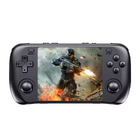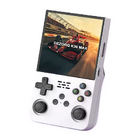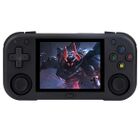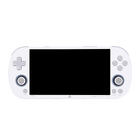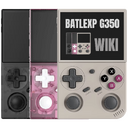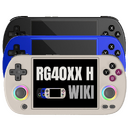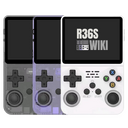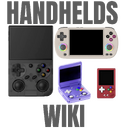TrimUI Smart Pro
| Pros & Cons of the TrimUI Smart Pro | |
|---|---|
| ✅ Pros | ❌ Cons |
|
|
Performance[edit]
SNES GBA PS1 NDS PSP N64 DC Saturn GC PS2 3DS Wii
The Allwinner A133P is a little faster than the H700 SoC. Most PSP games are running very good on this chip.
PSP Compatibility List (Plays most psp titles fine)
|
Price[edit]
~$50
Get the TrimUI Smart Pro: AliExpress1 - AliExpress US1
1 Buying through these affiliate links helps support the wiki. Your price stays the same. Commissions go toward devices, testing, documentation, and server costs.
Colors[edit]
More Images[edit]
More Information[edit]
Here's some helpful info for TrimUI Smart Pro owners (thanks to cruzrga for this):
- Wifi is not really great, it's awesome that TSP has it, and it works good enough but for game streaming (moonlight/sunshine) and such you will have to make concessions: on my home network (on my laptop I can get to 300mbps speed consistently via wifi) to get reasonably stable connection I have to use 30 FPS / 720p / 3000 bitrate (which degrades quite a bit the image quality)
- Lack of L3/R3 can be an inconvenience, especially for ports and game streaming (which honestly are both pretty good on TSP because of the awesome screen), but I wouldn't worry too much if your main focus is to play older consoles, since those didn't even had sticks.
- Analog sticks have a firmware/software bug that makes movement pretty bad and inconsistent (Russ mentions this on his video) but there is a fix for that (not mentioned almost anywhere, ironically), you can find the solution on this reddit comment if you ever need it: https://www.reddit.com/r/trimui/comments/1f8bk04/comment/lll6yr5
- Buy the device without SD Card, purchase a good branded one with high speed (preferably 128gb or 256gb if you can afford it) then go to TSP's github page and create a card (there are tons of tutorials on youtube, it's really easy to do). To fill the card with games, look for "Tiny Best Set: GO" and "Done Set"; you can also look for TSP's Telegram channels where folks share the original 64/128/256gb card files that come with TSP.
- Buy a glass screen protector, TSP's screen glass is pretty sketchy, but using a glass screen protector make it perfect. You can find on Aliexpress combos of screen protector+carrying case/silicone cover for pretty cheap
- A great part of the PSP library is playable, lots of games even at 2x resolution without frame-skip, but for most games you will have to configure the PPSSPP emulator to get the best performance (the same for DC/N64, although I haven't tested much of these and from what I noticed the performance on DC/N64 is more hit or miss while PPSSPP seems to have more configuration settings to mess with). For anything below DC/N64/PSP the TSP has more than enough juice and it's basically a matter of opening the game and playing it. You can find a PSP games compatibility list on this Sub if you look for it.
- Portmaster, despite being an awesome fit because of the 5' 16:9 screen of TSP, has smaller compatibility with games than Ambernic devices since the TSP's A133P CPU lacks 32 bit drivers support on Linux, and therefore can't run some games that work on H700 chipset of RG35/40/xx/h/etc (but A133P is actually a little bit faster than H700, so what runs, will play better on TSP). With CrossmixOS developer partnering with Trimui, maybe 32bit driver support will be added in the future, but that's completely unknown since driver support is more of an Allwinner thing than Trimui, I think.
- There are a ton of OSs for TSP out right now, and a few under development. For your initial setup, I would stick to Crossmix OS, since it's basically a better stock OS, but you should also try others like NextUI/MinUI, Knulli, GammaOS Core (still pretty experimental, but I have seen folks playing GTA:SA android version on TSP running GammaOS) and see what you like best.
- The initial batch of consoles had a pretty bad L2/R2 design that was a PITA to use, but it has been fixed a long time ago. Thought I should mention this also since not every review online is updated with this information. Also, the initial batch didn't had a heatsink/thermalpad on A133P and the back of the device got pretty hot to touch when using high performance mode (CPU@2Ghz), but that was also fixed and, at least on my TSP, I haven't had any of those issues (it gets warm to touch, but so does any other computer/console).
Videos[edit]
Firmware[edit]
| CrossMix-OS | |
|---|---|
 | |
| Latest version | 
|
| Download | ⬇️ GitHub |
| Documentation / FAQ | CrossMix-OS Wiki |
| Hotkeys | Shortcuts |
| Officially Supported Devices | |
| KNULLI | |
|---|---|
 | |
| Latest version | 
|
| Download | ⬇️ GitHub |
| Documentation / FAQ | KNULLI Homepage |
| Hotkeys | Hotkey Shortcuts |
| Officially Supported Devices | |
| MinUI | |
|---|---|
 | |
| Latest version | 
|
| Download | ⬇️ GitHub |
| Documentation / FAQ | Instructions are included in the download |
| Hotkeys | Instructions are included in the download |
| Officially Supported Devices | |
| SpruceUI / SpruceOS | ||
|---|---|---|
 | ||
| Latest version | 
| |
| Download | ⬇️ Nightly - ⬇️ Standard | |
| Documentation / FAQ | SpruceOS Wiki | |
| Hotkeys | Hotkeys | |
| Officially Supported Devices |
| |
| muOS (MustardOS) | ||
|---|---|---|
 | ||
| Latest version | muOS 2508.0 Goose | |
| Download | ⬇️ muOS Homepage | |
| Documentation / FAQ | muOS Homepage | |
| Hotkeys | Handy Hotkeys | |
| Officially Supported Devices |
| |
Other[edit]
NextUI: https://nextui.loveretro.games/
PakUI: https://github.com/tenlevels/PakUI
muOS and GammaOS are currently in testing/beta stage.
Stock OS: https://github.com/trimui/firmware_smartpro
Stock OS details for devs[edit]
OS: Tina Linux (Neptune, 5C1C9C53) - Based on OpenWrt
Kernel: Linux TSP 4.9.191 #407 SMP PREEMPT aarch64
BusyBox v1.36.1
glibc 2.33 (compiled with gcc 10.3.1)
libstdc++ 3.4.28
Full root access
/etc/openwrt_release
DISTRIB_ID='tina.raymanfeng.20240503.141812'
DISTRIB_RELEASE='Neptune'
DISTRIB_REVISION='5C1C9C53'
DISTRIB_TARGET='a133-aw3/generic v1.0'
DISTRIB_DESCRIPTION='tina.raymanfeng.20240503.141812 4.0.0'
DISTRIB_TAINTS='no-all glibc busybox'
Sunxi represents the family of ARM SoCs from Allwinner Technology.
See linux-sunxi.org/TRIMUI_Smart_Pro for more technical details.
Troubleshooting[edit]
Black screen[edit]
There are multiple reports of a black screen and the device seemingly not turning on, but only showing the red lights when charging. Those issues can sometimes be fixed by unplugging and plugging the battery back.[1]
Other Projects at the Handhelds Wiki

